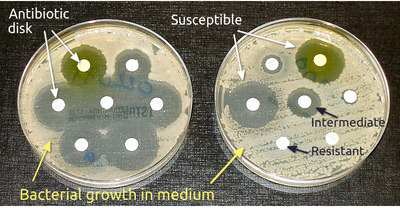Antibiotic Susceptibility Testing (AST)
|
Be sure to have senaite.ast installed |
Disclaimer |
|
AST, Antibiotic Susceptibility TestingA la Wikipedia, Antibiotic Sensitivity as the susceptibility of bacteria to antibiotics Antibiotic susceptibility testing, AST, is carried out to determine which antibiotic will be most successful in treating a bacterial infection. Minimum Inhibitory Concentration (MIC) is at its heart Small wafers containing antibiotics are placed onto a plate upon which bacteria are growing. If the bacteria are sensitive to the antibiotic, a clear ring, or zone of inhibition, is seen around the wafer indicating poor growth. Clinically, minimum inhibitory concentrations are used to determine the amount of antibiotic that a patient will receive and also the type of antibiotic used
Also see https://senaiteast.readthedocs.io/en/latest/index.html  |
Qualitative OutcomesThe plates are incubated for say 24 hours and the results are determined by the diameter of the growth inhibition around each antibiotic disk and reported in accordance with e.g. EUCAST's definitions Recommended thresholds, breakpoints, for the diameter of the ring sizes per susceptibility category, are available for most known bacterium and antibiotics combinations. These are the concentrations at which bacteria are susceptible to successful treatment The numeric diameter readings are interpreted using the breakpoint tables and reported as:
|
In BikaThis configuration is broken down as: MicroorganismsConfigure the Microorganisms in their categories, then select them from there for identification tests, and use in AST panels AntibioticsSet up the Antibiotics you are going to use Breakpoint TablesSet-up the breakpoint tables for the organism-antibiotics combinations for looking up the growth diameters for interpretation AST Panels
Requested on Samples
Results Capture
|


